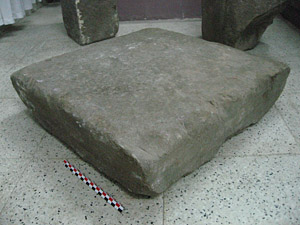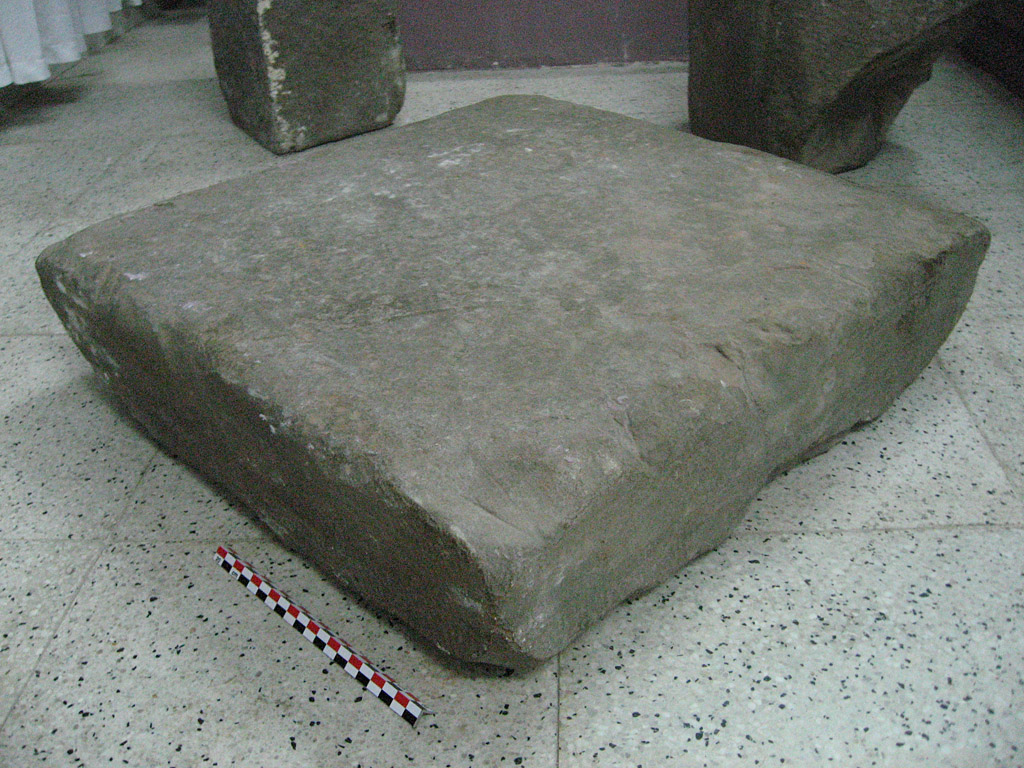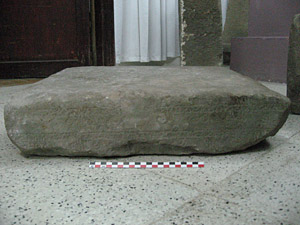Corpus of the Inscriptions of Campā










C. 173 Pedestal from Trà Kiệu
Please note: you are reviewing a preprint version of this publication. Contents here may change significantly in future versions. Scholars with specific interests are urged to consult all cited bibliography before using our texts and translations or drawing other significant conclusions.
Text The inscription runs over two lines along two of the four vertical faces of the object. The sequence is face A (“left”, two lines), face B (“right”, two lines). Written in Sanskrit.
Date 6th century Śaka (7th CE).
This piece was found by J.Y. Claeys at Trà Kiệu in 1927 (see Claeys 1927). We have not found any information on the question when it entered the EFEO Museum in Hanoi, but by the time the inscription was inventoried, as part of Cœdès' first supplement, in 1937 (IC vol. I, p. 273), it had been registered there as B 2, 38. We identified the stone in the Bảo Tàng Lịch Sử Việt Nam (National Museum of Vietnamese History) at Hanoi in 2009 and following years. While the stone was unnumbered when we first observed it (see ECIC III: 447), the museum staff subsequently assigned a new number to it so that in March 2012 we were able to record the current inventory number LSb 42277.
Edition(s) First published, with French translation, by Mus 1928; whence, translated into English, Golzio 2004: 11-12. Re-edited from the EFEO estampage, with new translation, in ECIC V: 434-437, whence the present edition.
Facsimile
- Estampage: EFEO n. 508.2
The following text was edited by Arlo Griffiths and Dominic Goodall.
Face A.
Face B.
Ib ślokaṁ ◇ ślokam Mus. — Ic puṅsaḥ ◇ pumsaḥ Mus. Doubtless a printing error for puṁsaḥ. — Id manu(jasyā)tma° ◇ mānuṣasyātma° Mus. — IIa [rāmasya] (ca)ritaṁ kṛts[n]aṁ ◇ x x x x ritaṁ kṛtyaṁ Mus. Our reading presupposes that this pāda is directly based on Vālmīki's Rāmāyaṇa 1.2.30a. — IIb (yenābhisādhanaṁ) ◇ yenābhiṣecanaṁ Mus. — IId cāvaner iha ◇ śru ⏑ ⎼ r iha Mus. — IIIa sthānaṁ ◇ °sthānam Mus. The word pūjāsthāna is attested in two other dedication inscriptions of the same king, viz. C. 79 and C. 136. — IIIb kṛta ⎼ Cy ⏓ ⏑ ⎼ ⏑ ⎼ ◇ kṛta x x y ⏑ ⎼ ⏑ ⎼ Mus. Compared to Mus, we assume one akṣara less before and one more after the one bearing a subscript y, on the supposition that we may restore something like kṛta[vān] ya .... — IIId sarvvāri° ◇ sarvāri° Mus. — IVc (jaya)ty eṣa ◇ x x ty eṣa Mus. — IVd [v]i[dhau] ◇ [r]i[pau] Mus. It seems unlikely that the enemy would be equated with the autumn, as Mus' reading implies. This is precisely the season associated with beauty of the moon (vidhu) due to its proverbial clear skies. The idea rather seems to be that the autumn moon itself would be eclipsed by the king.
Translation
Having restored here the place of worship for the primordial poet and great[est] sage of the earth, Vālmīki, from whose anguish was born the verse that Brahmā praised, (and) who has composed the complete, ... (abhisādhana?) acts of Rāma, the human own/bodily form of the ancient male, Viṣṇu, this king Prakāśadharman, who subdues all (worldly and internal) foes, who is cherished by the world (or: the goddess Earth), being endowed with the virtues of knowledge, power, forbearance, wealth, fame, and patience, is victorious as the beloved of [all] creatures, the autumnal moon having been eclipsed (by his glory)!
Commentary
Secondary Bibliography
- Claeys 1927: 478.
- BCAI 1917-30, 56.
- Trần Kỳ Phương 2000: 55-56.
Notes
- See BEFEO 27 (1927), Chronique, p. 478:
De même, servant de seuil dans le réduit d'une maison annamite située à l'angle des murailles de l'Ouest et du Sud, une pierre inscrite fut trouvée. Elle porte quatre lignes de sanskrit en écriture du VIIe siècle, commémorant l'érection d'un temple en l'honneur de Vālmīki. L'inscription occupe deux faces latérales, en angle droit d'une pierre carrée de 0 m. 54 × 0 m. 54 × 0 m. 12. Chaque ligne a 0 m. 50 de long.
Voici les renseignements qui ont été recueillis concernant son origine : il y a cinquante ou soixante ans, pour construire le groupe de maisons qui occupe cet angle des remparts, un tas de briques chames situé sur le versant Est du point A fut acquis pour 150 ligatures de sapèques. Ce prix élevé indique que la masse de briques était importante. Elle fut transportée au lieu où devaient s'élever les maisons. Parmi les briques se trouvaient quelques pierres. L'origine de la pierre inscrite est donc vraisemblablement le point A, si cette tradition est exacte.
- A photo print of the estampage n. 508 is kept with the estampage in the EFEO library. It has been digitized under the file-name EFEO-n508lég.jpg.



The text alludes to, and even directly replicates phrases from, the Bālakāṇḍa of Vālmīki's Rāmāyaṇa. See the observations of Mus 1928. The new reading of stanza II presented here adds significantly to the extent of our poet's dependence on Vālmīki, and simultaneously removes the need to presume, as did Mus, that Vālmīki is being identified as Viṣṇu. For the significance of the expression arigaṇa, see the commentary on C. 137. Since the word pūjāsthāna in the inscriptions of Prakāśadharman seems to refer each time either to the inscribed pedestal itself or to the place where that pedestal was installed, we cannot follow the reasoning in Trần Kỳ Phương 2000 identifying this ‘place of worship’ as the different and more famous pedestal from Trà Kiệu that is decorated with elaborate sculptural reliefs.
If abhisādhanaṁ is indeed the correct reading, perhaps it can be understood either as an adjective with the sense 'propitiating' (cf. Monier-Williams s.v. abhisidh) or as a noun, 'propitiation', in apposition to caritaṁ. We therefore tentatively propose interpreting this quarter-verse to mean: 'who composed, [as an act of] worship/propitiation, the complete Acts of Rāma'.